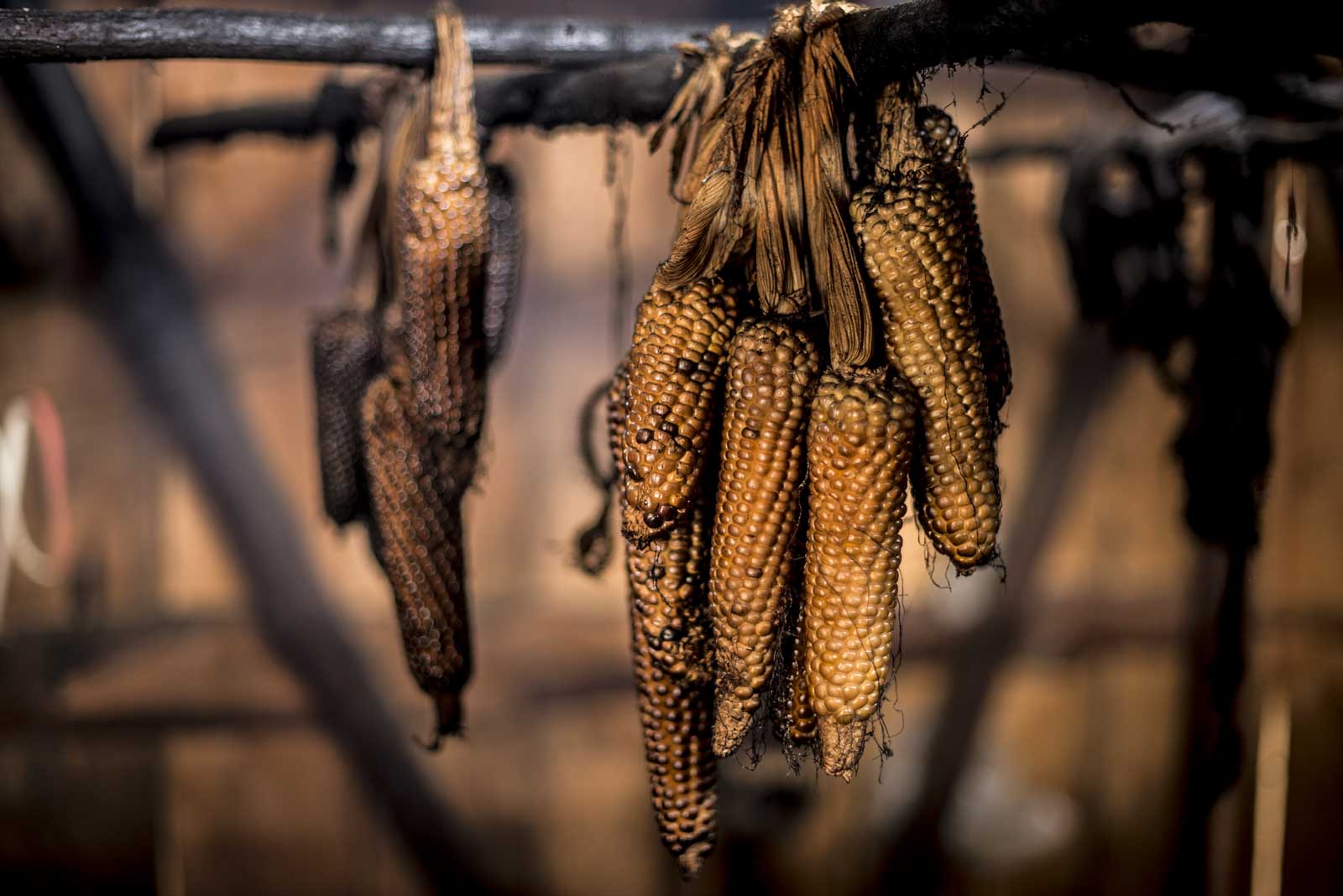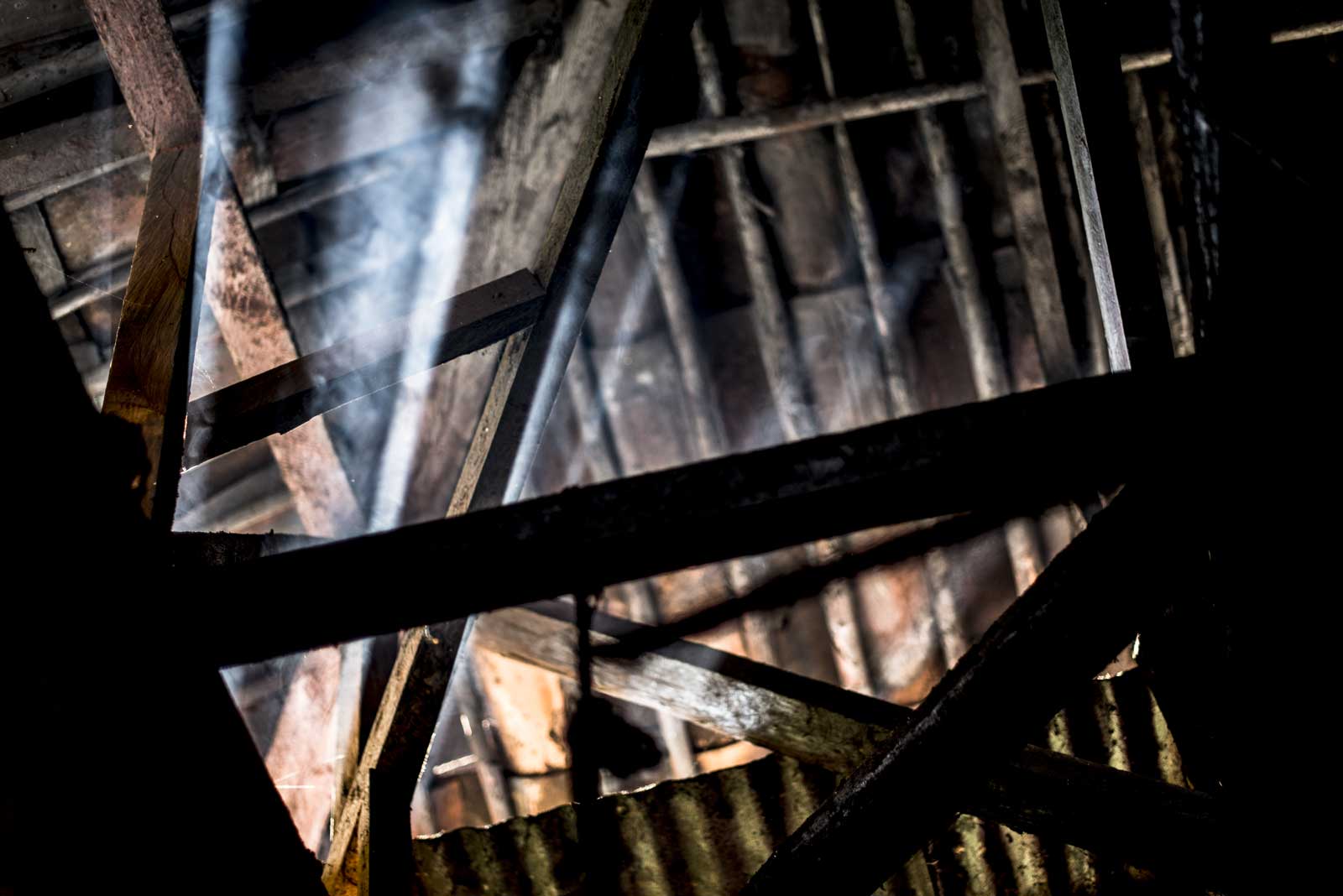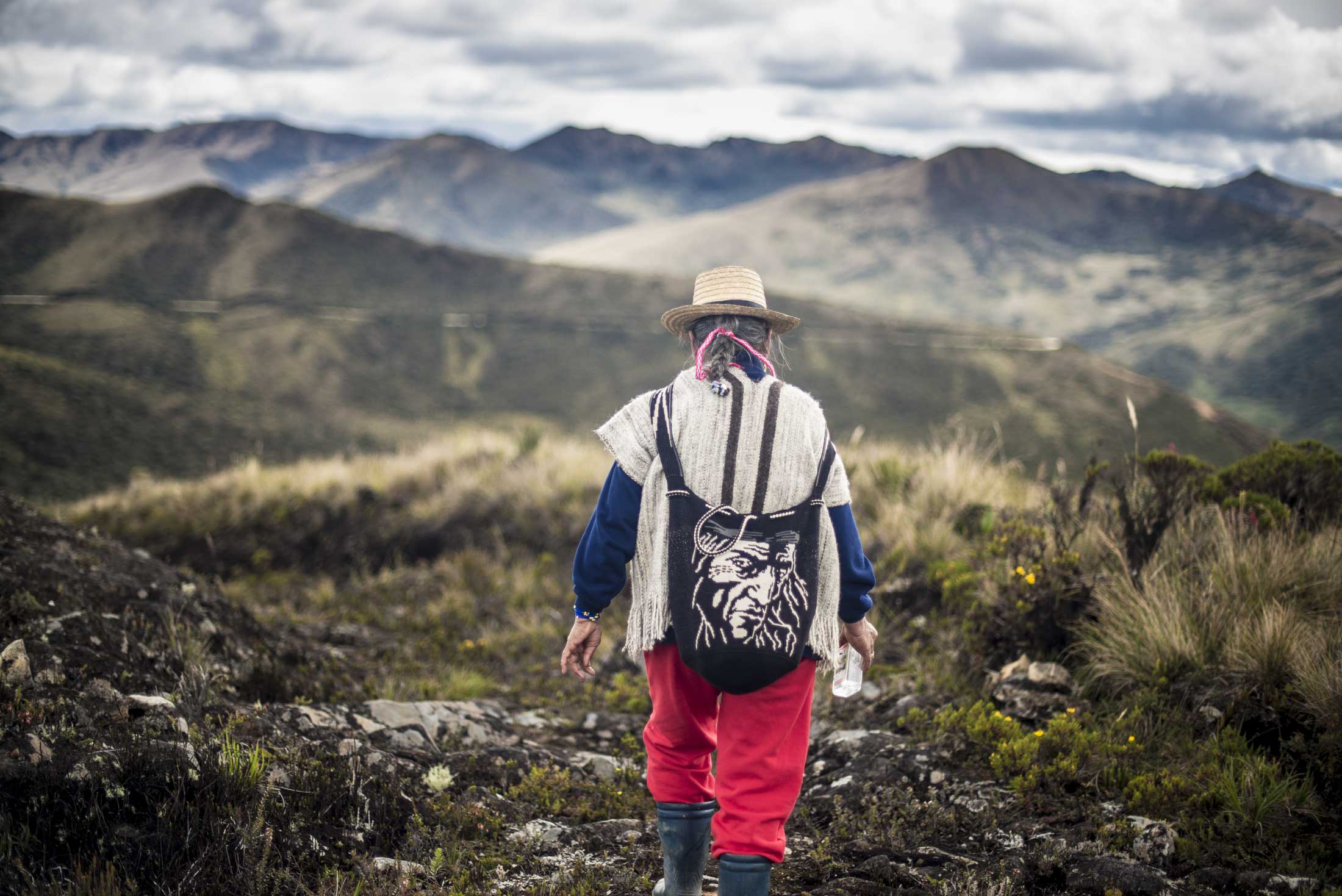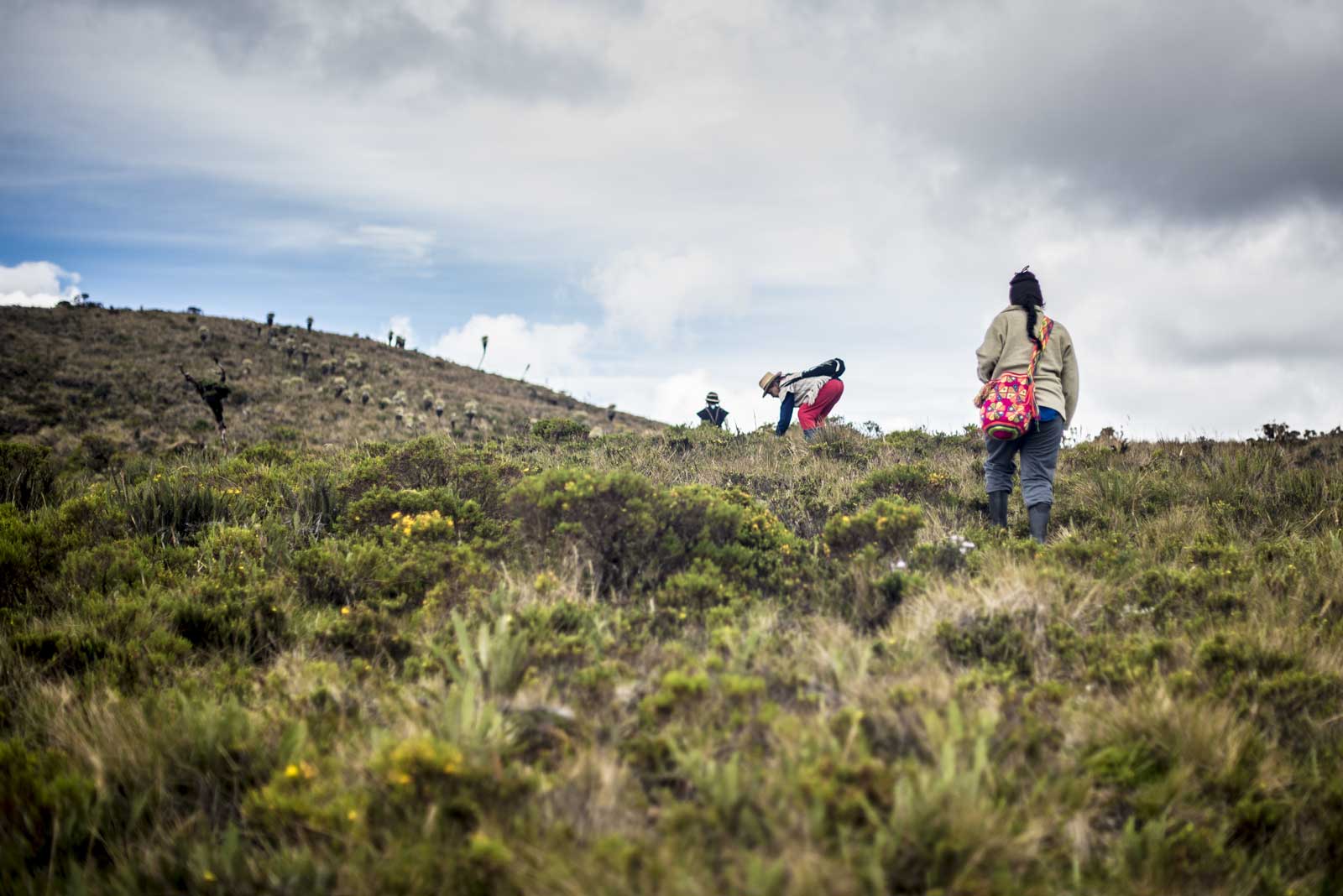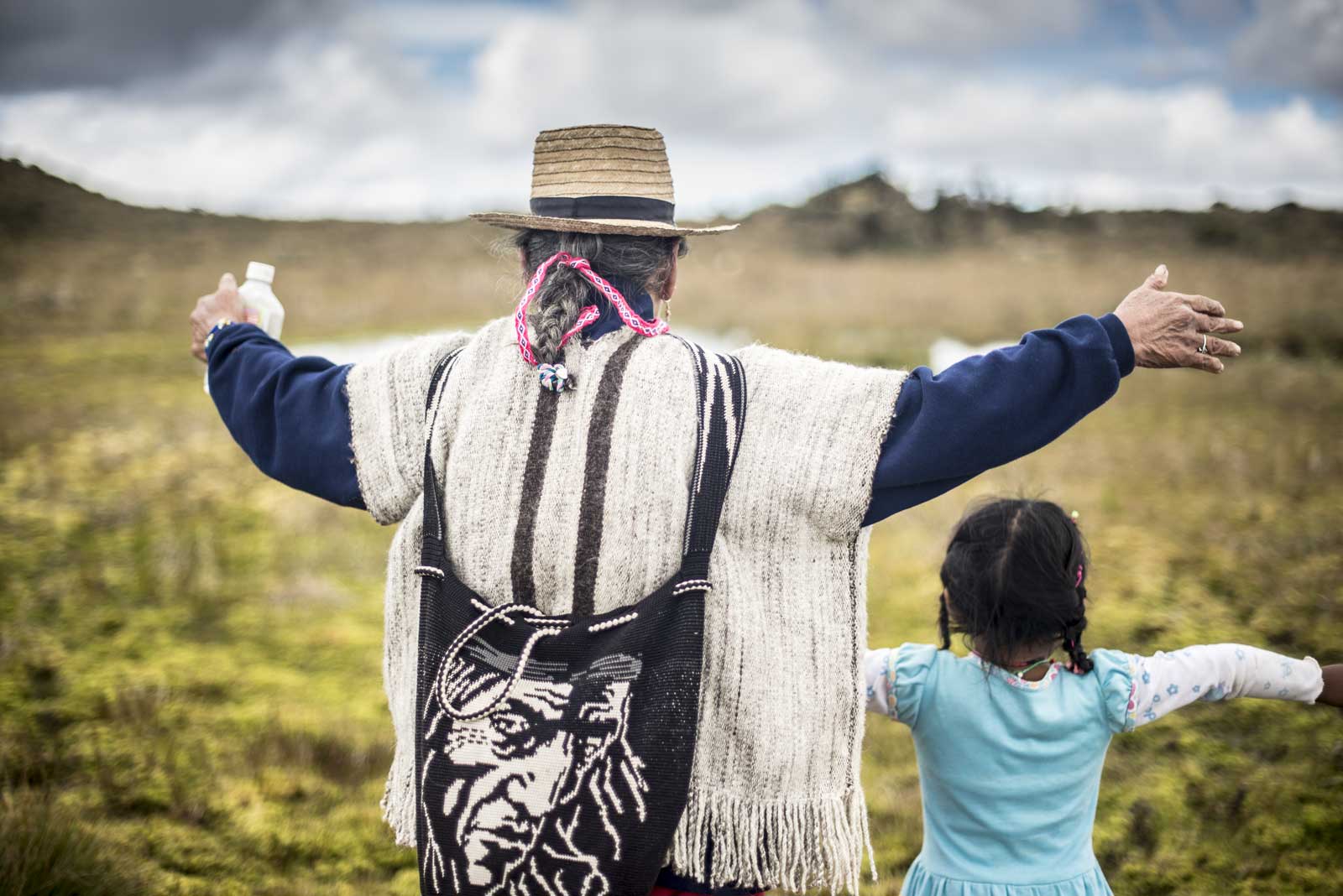1984, gunshots in Santander de Quilichao
In a hidden area in southeastern Colombia, following the western side of the Eastern Andes Mountain Range, right by the place where the Naya River quickly flows towards the Pacific Ocean, a column of smoke slowly rose over a kitchen’s roof, blending with the thick fog all around. Inside the soot-covered kitchen, three round stones –the father, the mother, and the son—held the fire in front of Blanca’s young face. For many, it’s a simple stove, but for Blanca and her people it’s la tulpa, the sacred space where knowledge is passed on and stories are told. With a few corn grains in one hand, or some cherry-colored coffee grains, Blanca, standing in front of the fire, heard the voice coming from the radio: …murdered… Father Álvaro… gunshots… Santander de Quilichao…
Immediately, Blanca left her small children on a neighbor’s care, and, with another child growing in her belly, she departed towards Santander de Quilichao, a hand-knit bag strapped across her chest. She walked through roads that crisscross the mountain’s skin like scars. After nine hours, she finally arrived. The protest was already huge. She, like all the others, had a wounded heart that was filled with rage.
Everything had taken place in the children’s home. The car had honked and inside a small girl had ran to open the gate. With her face pressed against it, she managed to see a man on the other side of the street stepping down from a motorcycle and walking towards the car. As he crossed the road, the man took out a gun and headed towards the window where Father Álvaro waited with his hands on the wheel. Behind the gate, the girl’s eyes met the man’s eyes. She didn’t scream. She couldn’t find words. When the shots rang around her, she was still like a statue. The car door opened, and father Alvaro fell on the dirt road. The man retraced his steps and squeezed the trigger several more times. The motorcycle then sped away at full speed. It was mid-morning of a black November Saturday in Santander de Quilichao.
Unlike most of the men who used to preach from their golden pulpits, Father Álvaro wasn’t white, or mixed race. Father Álvaro, née Álvaro Ulcué Chocué, was, like his friend Blanca, part of the Nasa indigenous people. He was the first indigenous priest in Colombia, and he spoke, in chapels and in the mountains, not only about the Catholic God, but also about stolen lands, human rights, and the strength of the indigenous people.
Blanca and all the others who gathered to protest Father Álvaro’s death in the following days chanted amid the smoke of burnt tires. They blamed the region’s sugar cane plantation owners, landlords, members of the Police, and the F2, the military intelligence organism back then. Stones were thrown, bullets fired. There were wounded among the indigenous men and women who were mourning the priest. There were wounded among the uniformed police officers.
Until that day, Blanca had been fulfilling her duties as a school teacher while at the same time she handled the target set on her chest by guerrillas of the Ricardo Franco Command *, who had already started their paranoid plan to rid their ranks of anyone that smelled of traitors or informants.
Ricardo Franco Command, a dissident FARC guerrilla group remembered for executing the Tacueyó massacre. Between November 1985 and January 1986, leaders of the Ricardo Franco tortured and killed at least 164 of its own members, accusing them of being Colombian Army and CIA moles.
Several months before that sad Saturday, in her house on the mountain skirts, Blanca saw Father Álvaro. She had some books she was supposed to hand him back and he, heedless of the threats, arrived after nine p.m. behind the wheel of his little car.
– Don’t worry, Blanquita. They don’t kill you when they say they are going to kill you, but rather when your time comes. Besides, I don’t travel by myself. God and the spirits are with me.
Father Álvaro wasn’t the first one to die back then in Cauca, a land of mountains and fertile valleys that was plagued by armed people. Those were the years in which the sons of the millenary owners of those lands organized themselves and decided to get back what their grandparents, their Nasa forebears, had given them as their inheritance: their territory.
–Don’t worry, Blanquita, you keep on going forward. If they kill me, you’d still be around to keep on fighting. That’s what Father Álvaro used to tell me.
That’s what her friend Moncho also told her, what her husband Maximiliano used to say, and her mother probably said something similar when she extended the pita fiber to start knitting. They all left, they all died. Blanca stayed behind. Today, with her gray hair under a hat, she walks through the sacred Páramo in Tierradentro, the territory of the Nasa indigenous people. Blanca greets the spirits and makes offerings to the same land that has seen so many pass, so many die. The same land that gave birth to Quintín Lame, the Nasa man who became a legend. The same land that, decades later, gave birth to Quintín Lame, the indigenous guerrilla fighter.
The Seventies and before.
By the start of the decade, there were already many Nasa who had fallen in the hands of “The Birds,” the gunmen who worked on behalf of the interests of the landowners who had stripped huge parcels of land from the Nasa territories. While the Nasa organized themselves to fight for their autonomy and their land in what came to be known as the CRIC (Cauca’s Regional Indigenous Council), an armed alternative that started as a small self-defense group was parallelly established. The group would later become the Quintín Lame Armed Movement, named in honor of an indigenous leader who, according to some, was jailed 108 times for insisting in organizing his own to get back their lands in the early twentieth century. He was a lawyer for the indigenous people, the man responsible for leading them to abandon their condition as terrazgueros *, the man who fought for the territory and the identity of the Nasa people, the man who now leant his name to baptize what many call “the first indigenous guerrilla group in Latin America,” the same one that fought on behalf of ethnic and territorial interests within a much larger conflict.
Terraje refers to the old colonial relation in which indigenous groups were forced to pay a rent in money or work to be allowed to live in an area of an estate called an “enclosure.” The terrazgueros paid the terraje by working for the landowner several days a month or by giving him part of their products.
In Cauca, since the time of the Spanish Colony, the Nasa and the Misak have lived in reservations. Nevertheless, the pressure to reduce their communal lands to expand the areas of settlers and landowners expelled many indigenous and turned many others into terrazgueros in large estates. Even though the landlords discouraged any sort of opportunity, some indigenous like Quintín Lame learned the language of the whites and the laws that could help them defend their reservations.
In the early twentieth century, the fight to abandon terraje and strengthen indigenous reservations continued. The violence against those followed Manuel Quintín Lame was then unleashed. Strong reservations and an indigenous population who was proud of their pasts and destinies wasn’t something that the landowners, the settlers, and the local authorities cared to permit.
In the seventies, Cauca was still a scenario of indigenous fights for territory and culture. The people had organized, and they had started to be a part of the The Taking Back of Mother Earth, an initiative to recover lands that had been usurped from reservations and collective property. And, once again, violence arrived.
While indigenous communities organized themselves and formed the CRIC, while people died at the hands of gunmen who had been hired by those who refused to give back their lands, visits and guns started roaming the life of Blanca, who had married Maximiliano and given birth to several children a few years back. The young couple had long and repeated discussions. The reason for them had to do with the time that Maximiliano dedicated to the family and with the time that he spent worrying about communal concerns about the growing deaths of those who were fighting to recover their territory.
– Maximiliano, my husband, was a smart Indian, very smart. But back then, what I did was fight with him because he didn’t live with me, because he wouldn’t stay with me. Thing is, we’ve been educated in a society where life at home means being among the pots and pans, working, accumulating.
One time, they were both logging wood to build the house with when, suddenly, they saw soldiers far away. Maximiliano saw them first. Immediately, he fled through the mountain like a ghost, running on the edge without moving the leaves and branches around him. They were coming for him. They said he was involved with armed indigenous self-defense groups. That time, like so many others, they couldn’t take him. Instead, they took Blanca, who was forced to leave their children with their grandmother, and then made to walk the Páramo under the soldiers’ orders. They walked to Silvia and from there rode a truck towards Popayán. A prison cell waited for her there. They tried to make her confess the source of the indigenous groups’ weapons, the name of the commander, and who was teaching to aim and shoot. In the cell, Blanca slept poorly while she waited to get out, while she waited for food, and waited for water.
– They wanted me to tell them lies, truths, whatever. But since I knew nothing, what could I make up? Eight days later, they set me free. I looked like a starving dog.
In those days of 1976, while the revolutionary groups slowly arrived in the mountains, the Páramo and the thick forests of Cauca, you could see proud indigenous men poorly armed with flint rifles and machetes patrolling the mountains and their communities. Among those hard, golden faces, was Maximiliano’s.
Blanca recalls that back then, when Maximiliano barely spent any time at home, guerrillas from the M-19 * arrived in the mountains. They were different from the locals. They were taller, black and white, and they usually arrived at midnight or before dawn.
M19, Movimiento 19 de Abril, a guerrilla that was born following an electoral fraud in the presidential elections of April 19, 1970, in which Misael Pastrana was declared the winner. In 1990, after several years of fighting and carrying out guerrilla actions mostly in the country’s big cities, the M-19 signed a peace agreement with the government and laid down their weapons.
The M-19 came and with it came the possibility of alliances for the armed indigenous groups, the possibility of gaining access to less precarious weapons and of learning new tactics of war. In 1977, the M-19 commanders, Jaime Bateman and Iván Marino Ospina, led the first instruction school, where indigenous people from the self-defense groups learned to use real weapons. In exchange, the guerrillas were harbored in strategic mountains.
Back then, as the Army and The Birds captured and killed indigenous leaders arguing that they were dealing with the guerrillas, Blanca used a thousand different arguments to convince Maximiliano –who was now Maximiliano Moctezuma of the M-19 that he should stop thinking about weapons.
–My father used to say, “You, mija, why do you get involved with him? He is a guerrilla fighter, and he is either going to end up dead, or in jail. And you with those kids, where will you end up?” And, precisely, that’s how my life turned up. But, at least… I learned a lot from him. He didn’t… no, he wasn’t going to die, or go to jail because he was a thief, or a criminal. He was going to [die or go to jail] because he was a defender of the rights the indigenous people.
The training continued, and the weapons and the armed men kept arriving. In 1979, the M-19 executed Operation Blue Whale, a spectacular action in which, after months of intelligence gathering, they built tunnel under the Cantón Norte, an Army building in Bogotá that, seen from afar, reminded them of an enormous sea mammal. Right in the middle of the new year’s celebration, the guerrillas stole 5,000 Army weapons and left stamped on the wall the famous phrase of a comic Latin American superhero: “You didn’t count on my wiliness.” Many of those rifles from what is still the largest arms heist in Colombian history ended up in Tierradentro, Cauca. With the weapons, the Army and repression arrived. They tracked down and locked up not only the members of M-19, armed indigenous groups, and those who allegedly assisted them, but also CRIC, the legal organization who fought for the land and the survival of the indigenous culture. Roads were militarized, and massive arrests followed each other once again.
Around those days, Blanca visited her friend Moncho, who had been recently jailed. That was before he became the first commander of the Quintín Lame Armed Movement. She visited him and several other jailed friends while the weapons taken from the Cantón Norte laid buried in the mountains. Back then, she recalls, Moncho had met people from the M-19, but that was it. It was only after he got out of jail that the idea of the Quintín Lame Armed Movement finally took shape.
–I saw Moncho later, in Mosoco. I said to him, “Moncho, what are you doing nowadays?” And he said, “We are fighting because we must defend ourselves, [we must] defend the comrades who are taking back [the territory], because The Birds are killing us. We can’t do nothing.” And that’s when they formed the group.
What followed was a war with multiple fronts. While the Quintín Lame Armed Movement grew and strengthened itself, the M-19 headed south, towards Caquetá, to protect itself after the persecution unleashed as a result of Blue Whale. It was then that FARC, with its Sixth Front, rushed to consolidate its presence and political power in the mountains of Cauca, where CRIC was already a major authority in indigenous territories. There were many fights, many dead, and many exposed. FARC, they say, treated those who were recovering territories as thieves and protected landlords. In this scenario, the Quintín Lame Armed Movement, independently of any other group, consolidated itself as a guerrilla that fundamentally supported all actions aimed at taking back their land, expanding indigenous reserves, and defending indigenous authorities and the right to autonomous government.
The Eighties, years of mourning and struggle.

Blanca remembers seeing Maximiliano hauling every now and then some of the Cantón Norte weapons from some hole in the ground. He would take them out, clean them, oil them, and place them underground again. He would rebury them in places only he knew, as if they were bodies or corn seeds. Those weapons were in his charge and they would be turned over only when the community decided what to do with them.
Blanca also remembers that day in 1984. She was in a meeting with Father Álvaro, in Tolima, shortly before they murdered him. For several years now, they had been talking privately and publicly about the indigenous woman, about the need to acknowledge the role of women in defense of life and territory. Today, Blanca recalls a phone call, she can almost hear once again the voice at the other end of the line:
–Comrade Blanca, you must come back. They’ve killed your husband.
Blanca knew that Maximiliano would never reach old age. He surely knew it as well. Not long before she received the phone call, she had been anxiously practicing traditional medicine with a spiritual major, a The Wala, as the Nasa call them. Using sacred plants and the wisdom of the Thunder, the The Wala reached out to Maximiliano, who spiritually told them:
–I am like a dead man already, don’t fight for me.
Blanca, stunned by the pain, headed towards the place where Maximiliano’s body was kept. She then sought and found his killers. She was carrying a gun in her belt when she saw them running and was suddenly face to face with Moncho, her friend, the friend of Maximiliano. Moncho hugged her and gave him a pill to calm her nerves. He admitted it had been a mistake, that it had all been because of the buried weapons. She turned down his help, but Moncho said that he would look out for her and her three children until the day he died, which wasn’t long after.
–People ask me about it and if it’s someone I don’t trust, I’ll say that he was killed by the enemy, even though he wasn’t. Maximiliano was killed by his own people for that reason, for what he used to tell me: I won’t deliver those weapons.
Blanca first met Maximiliano when she was 13 years old. She met him there, in the sacred Páramo, in Tierradentro, where he was born. It was in the town that lays closest to Nasa people’s most holy place, the lagoon where Juan Tama *, the son of the Star and Thunder, rested after coming to earth to fight the invasion of the Spanish colonizers, after coming to teach his people how to defend its territory.
uan Tama was an important chief of the Nasa people. It’s presumed that he led his people sometime in the sixteenth century. He became a fundamental part of the Nasa cosmology. He is said to be the son of the Star, a leader of the resistance against the Spanish colonists, and a teacher of cultural expressions and the rules of Nasa coexistence.
–I think my husband comes from a very sacred place. That is why he had that wisdom, that knowledge. I used to tell him that we should start working, that there are people who work who accomplish things and do alright. He said, “Blanca, that’s not living. What we must do is teach people how we can free ourselves, because this State won’t guarantee the life or future of our children.” consigue cosas y andan bien. Él decía “Blanca eso no es vida. Hay que andar es enseñando a la gente cómo nos debemos liberar, porque este Estado a nosotros no nos garantiza vida para el futuro de nuestros hijos”.
After the death of Maximiliano, Blanca, then only 25, felt that she was broken.
–I was left like a jug with no water, floundering here and there. Then I listened again to Father Álvaro, who had just arrived to give a mass. In the mass, he didn’t talk like the other priests. He spoke of reclaiming our rights. He said that the indigenous people also had heads, that we also smart. We’ve been numbed, enslaved. We’ve been deprived of our riches. We’ve been left behind like naked children. But, he said, we are also rich. We are not poor.
Following the pain caused by Maximiliano’s death, her road became firmer and she began not only participating, but also leading the Taking Back of Mother Earth.
–When they killed him, Maximiliano, it was as if my spiritual cassette was unleashed. I started doing many things, recovering land, and denouncing back them the persecution against the organization (CRIC).
Then, there came the threat of the Ricardo Franco Command and she fled towards the Naya River with her children. The news of Father Álvaro’s murder brought her back. And the priest’s words rung in her head: “If they kill me, you’d still be around to keep on fighting.” And what followed was the struggle.
Roots in the Páramo
Maximiliano was gone, Father Álvaro was gone, Moncho was killed in an ambush, and Blanca’s mother died when a truck filled with pita fiber fell off a cliff. Many others died fighting to take back the lands of the reserves, shooting their rifles, feeling the bullets against their flesh. In their territory, the drug trade kept growing, and the poppy, coca and marihuana plantations attracted paramilitary groups.
As the war changed and grew like a many-headed monster, several seeds sprouted their roots in some mountain, in Cauca. Amid the beans, the corn, and the poppies, the belly buttons of Blanca’s children and the rest of the Nasa newborns grew like plants, as tradition mandated, buried under the ashes of the tulpa or the feet of massive trees. Next to the belly buttons in the earth, the rifles sown by Maximiliano also sprouted their roots. The cannons and the triggers of unfired guns bloomed beneath the soil.
The Quintín Lame continued with its actions, sometimes independently and a few times in alliance with other guerrillas. In 1991, they deposed their weapons. There were various reasons, including community pressure to prevent the armed struggle from interfering with the consolidation of indigenous authority and community power. The indigenous guerrillas, dressed in olive green, laid down their arms and came back home*.
Early in 1991, the Quintín Lame Armed Movement gathered in Pueblo Nuevo, Caldono, to negotiate with the Colombian government. In May of that year, 150 combatants finally deposed their weapons. In 2017, in another area of Pueblo Nuevo, a group of former FARC combatants also gathered to depose their weapons as part of the Peace Agreement negotiated in Havana, Cuba.
Blanca, moved by the strength of her dead, started leading the struggle to reclaim the Nasa’s lands, indigenous autonomy and the civil liberties that, after much toil, were reflected in the new Colombian constitution, which admitted the existence and rights of indigenous people, afro-Colombian communities, and raizales.
Blanca became a leader. She was the governess of her reserve and, while in that post, was forced to live with the war. She dealt with armed squadrons. She dealt with ghost planes that suddenly shook the mountains with its strenuous fire and that, occasionally, fell to the ground riddled with the bullets that came from below.
Blanca became a grandmother and a Mayora, a position that, in Nasa communities, is reserved for people who have several decades of invaluable history on their backs, and a deep cultural and spiritual knowledge that allows them to serve as guides.
–Sometimes, they say that women are the weaker sex, that we are frail, and no, quite the contrary. If we can give birth, it’s because we are very strong. The thing is that the education itself, the system, has made us look weak, delicate, ‘slow.’ No, we are very smart and very strong. I say it with myself in mind. I’ve had to deal with a lot of things…
Blanca, Mayora Blanca, walks with her granddaughter and her daughter, the last one, the one who spent a short time in the ranks of FARC, the same one who returned amid the furious roars of Father Thunder, which that day boomed over the skirts where her house stands. The three of them walk in the sacred Páramo of Tierradentro. They’ve asked the spirits for their permission because you can’t just go in like a thief in the night. They bathe in the freezing water of the creek, where they clean themselves. They visit the three stones at the top of the mountain that look towards Laguna Seca –like the tulpa, they are the spirit family, she says. The stones are the father, the mother, and the little child.
Mayora Blanca talks to the mountain in Nasayuwe * as she lets drops of chirrinche fall to the ground she has trodden hundreds of times. She is strengthened by that ground, the ground where Maximiliano was born, where men and women have marched with rifles on their shoulders. This is the ground of Juan Tama and Quintín Lame, the man. The ground where the lives of those who have never bore arms keeps on going in front of the Nasa gods.
Nasayuwe, the language of the Nasa indigenous people.
